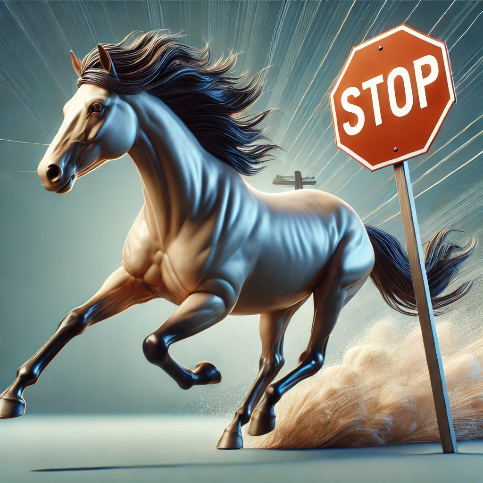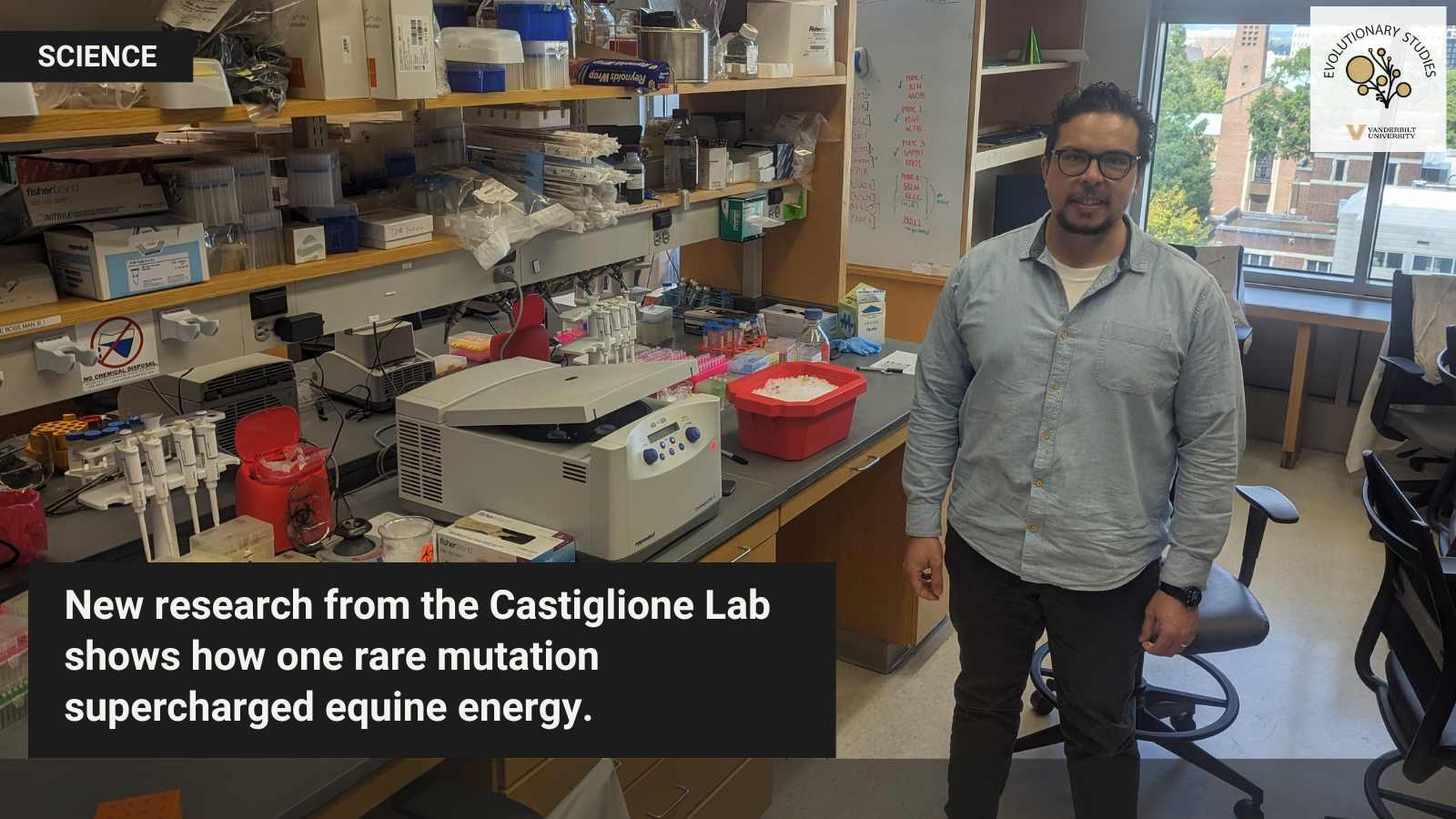Castiglione Lab Discover Horses Run Faster by Ignoring an Ancient Mutation that Says ‘Stop’
By Andy Flick, Evolutionary Studies scientific coordinator
Evolution often makes a deal with the devil, creating challenges for treating human disease. By mass, the muscles of thoroughbred racehorses consume more than twice the oxygen of elite human athletes. Yet, oxygen produces free radicals, which damage organ tissues. Balancing energy production with oxidative stress is also a major challenge for extending lifespan, as well as treating epilepsy and Parkinson’s disease. How did horses overcome this ubiquitous challenge to become paragons of athleticism? The answer seems to be by using a genetic trick previously thought to occur only in viruses. Gianni Castiglione, assistant professor of biological sciences and ophthalmology, observed, bridges disease with evolutionary adaptation.

New work from the Castiglione lab and that of collaborator, Elia Duh (Johns Hopkins), is shaping the way is shaping the way we understand the evolutionary limits of energy production. He discovered that the horse, an oft-studied, physiological powerhouse, evolved an enigmatic and ancient mutation that enables horses and their relatives to produce extreme amounts of energy while avoiding deleterious side effects.
The new work, “Running a Genetic Stop Sign Accelerates Oxygen Metabolism and Energy Production in Horses,” was published in Science on March 28, 2025. The team discovered that a rare mutational phenomenon known as opal recoding—occurring in only 0.1% of proteins—evolved in a horse ancestor millions of years ago. Unlike those other 0.1% of proteins, this opal recoding event facilitates adaptation, specifically by enhancing exercise performance by altering the biochemistry of muscle cells. This biochemical pathway also has major effects on lifespan and neuronal disorders.
Castiglione’s work was assisted by the well documented fossil record of horses, which chronicles their ascent from dog-sized ancestors into modern physiological powerhouses. This record is one of the earliest examples used in biology textbooks to showcase evolution and transitional forms. In fact, in the first books used that covered evolution at Vanderbilt, Nicholson’s Textbook of Zoology (1883), notes, “all the varieties of Horses appear to be descended from the single species Equus caballus.” Certainly, this is a proper system to showcase the power of evolution.
The team investigated a pathway that is well-known by both the exercise science and clinical communities to enhance energy production but avoid the tissue-damage associated with excessive metabolic activity, such as that seen during exercise, and in energy demanding tissues, such as neurons.
This pathway (NRF2/KEAP1) senses free radicals and then mounts a cellular response.
According to Castiglione, “oxygen metabolism produces energy for cells, but a side effect is free radicals (molecules with unpaired electrons) that cause extensive cellular damage, dysfunction and death if not counterbalanced by antioxidants. This oxidative stress damage accumulates over our lives, leading to aging. Our bodies produce antioxidants, and these are proteins and small molecules regulated by the transcription factor, NRF2.”
He continued, “importantly, NRF2 cannot always be active, because too much antioxidant activity can trigger cancer and can even be lethal. Thus, KEAP1 evolved to mitigate NRF2 activity by binding to it and destroying it. When KEAP1 senses free radicals, it physically releases NRF2, allowing it to trigger cytoprotective antioxidant gene expression.”

According to the manuscript, NRF2/KEAP1 is a major target in chronic diseases like emphysema but has also facilitated the vertebrate transition from aquatic to terrestrial life by protecting against UV light-induced oxidative stress, and more recently, as Castiglione previously found, during the evolution of birds to counterbalance the highly energetically demanding flapping during flight. The team found that horses have exploited this system as well. They show that a KEAP1 mutation present in all horses, donkeys and zebras, makes muscle cells more resistant to free radical damage.
The mutation has an additional benefit: it increases energy production through the muscle cell’s mitochondria, giving horses and their ancestors the best of both worlds.
Castiglione said, “in 99.9% of known proteins, this mutation in horse KEAP1 would stop protein production (opal stop codon), However, we found that the opal stop codon is recoded into the amino acid cysteine, and it is this amino acid’s unique sulfur group that favorably alters horse biochemistry. Previously, it was thought that this opal recoding was only adaptively useful in viruses as they adapt to selection pressures. It seems that predatory selective pressures imposed on ancient horses were so intense that they had to dig deep into the evolutionary bag of tricks to enable novel locomotion capabilities.”
Beyond understanding the evolution of horses and their relatives, this work can pave the way for novel treatment strategies for multiple diseases. In fact, Castiglione explained, about 11% of all human diseases are caused by the premature stop codons that horse KEAP1 have evolved to overcome through additional adaptations in other proteins and RNA-based mechanisms. Castiglione’s team is developing gene therapies that deliver these horse molecules into mice to improve stop codon recoding. Moreover, KEAP1/NRF2 is a goldilocks pathway, where its therapeutic benefit becomes a cancer-causing agent if it is too active.
The horse mutation in KEAP1 hits that sweet spot of moderate activity, creating a new molecular target to modulate NRF2/KEAP1 to a desired level of activity. This can therefore inform strategies targeting NRF2/KEAP1, such as in the treatment of emphysema, Parkinson’s and epilepsy, where free radicals are in excess, and/or energy production is dysfunctional.
Moving forward, the Castiglione lab is exploring a suite of other energy-related adaptations that they have discovered in horses, while leveraging these into new treatment strategies for humans (and horses) through collaborations at VUMC and the University of Pennsylvania.
Castiglione concluded, “our graduate students, Nadir Dbouk and Anamika Bose, greatly assisted with this project, while graduate student Joshua Eis is working on the NRF2/KEAP1 system in birds, where we hypothesize it is responsible for their roughly three times longer lifespans relative to mammals.”
Citation: Castiglione, GM, Chen, X., Xu, Z., Dbouk, N.H., Bose, A., Carmona-Berrio, D., Chi, E.E., Zhou, L., Boronina, T.N., Cole, R.N., Wu, S., Liu, A., Liu, T., Lu, H., Kalbfleisch, T., Rinker, D., Rokas, A., Ortved, K., and Duh, E.J. 2025. Running a Genetic Stop Sign Accelerates Oxygen Metabolism and Energy Production in Horses. Science. 387 (6741): eadr8589.
Funding Statement: Castiglione was supported by an R35 early-stage investigator award (1R35GM155367-01) and a pilot grant from the Evolutionary Studies Initiative. This work was also supported by National Institutes of Health grant EY022383, National Institutes of Health grant EY022683 (EJD), Altsheler-Durell Foundation (EJD), Research to Prevent Blindness (EJD), Wilmer Eye Institute, Imaging and Microscopy Core Module P30EY001765.
